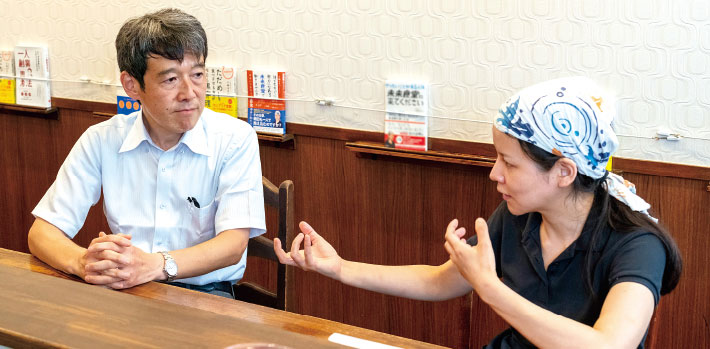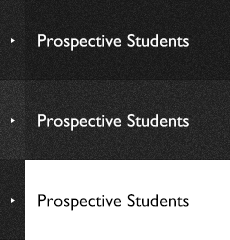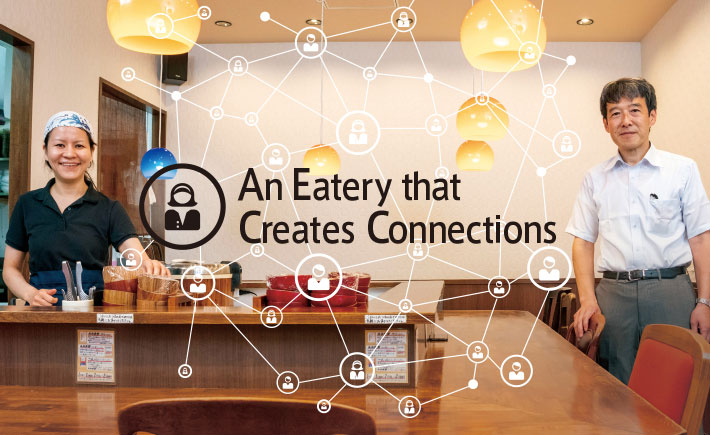
In the future, how will human and information networks expand?
Sekai Kobayashi is the owner of Mirai Shokudo, an eatery with twelve counter seats in Jinbocho, a neighborhood near Tokyo Station.
At her eatery, attention is given to each individual customer using unique methods called makanai, where a free meal is provided to customers who help with work at the establishment, and tadameshi, in which customers receive a free meal on behalf of someone who worked for a makanai.
Professor Tsuyoshi Murata examines the spread of human relationships via network structures by conducting research on themes such as social network analysis and web mining.
In the coming era, communities will be connected on the internet. How will networks change with the spread of information in this new age?
Kobayashi and Murata discussed related issues from each of their unique perspectives.
(Date of Interview: September 15, 2020, at Mirai Shokudo)
Flexible connections centered around the eatery
KobayashiProfessor Murata, I was really looking forward to meeting with you today because I graduated from the Department of Mathematics at Tokyo Tech. What do you think of the eatery?
MurataActually, I used to work at a research institute in Jinbocho, so I am familiar with the neighborhood. I was interested to learn that a person with a background in the pure theory of mathematics was opening an eatery in Jinbocho. Personally, I don't like worrying about what to order, so an eatery serving one lunch that changes daily is great for me. Do any of your customers complain about this system?
KobayashiActually, since customers don't have to decide what to order, the system is popular among people who want to finish their lunch quickly. Since the menu changes daily, every day is different and no fixed items are served. Although this system does not offer a numerical advantage—for example, something like "our lunches as cheaper than other restaurants by XX yen"—it is a strength in terms of differentiating Mirai Shokudo from other restaurants. At the same time, it is a disadvantage because I can't expect repeat customers who keep coming back for the same signature dish.
MurataYour management ideas are quite theoretical, and you have established many unique rules and systems. For example, the tadameshi ticket is a kind of asynchronous communication such as a letter left behind or a message, something you won't find on SNS. Your eatery serves as a center that connects people by disseminating information with a time lag and anonymity. Normally, a community spreads like a network. However, the idea of a structure that connects people with an eatery as the base is interesting. It seems that you are intentionally trying to create such a place.
KobayashiEver since I first opened the Mirai Shokudo, I have been conscious of the relationship between the eatery and customers, leading to the creation of the current form. Mirai Shokudo only seats twelve diners. This small size creates a single community of customers who like eating here. In turn, this has the problem of creating a feeling of exclusion for those not in that community.
MurataLike a restaurant that requires an introduction from a regular diner.
KobayashiExactly. So, instead of a restaurant which is difficult for first-time customers to enter, I want Mirai Shokudo to be "a place where everyone is welcome and everyone fits in." When I imagined a place where anyone could eat and feel like they are contributing, I thought it would be risky to position a fan-based community at the center of management. Anyone can use the tadameshi ticket, in which a customer who has worked for makanai can give away a free meal. In the majority of cases, however, the person giving away the meal and the person using the tadameshi ticket never even meet. This relationship is a feature of Mirai Shokudo.
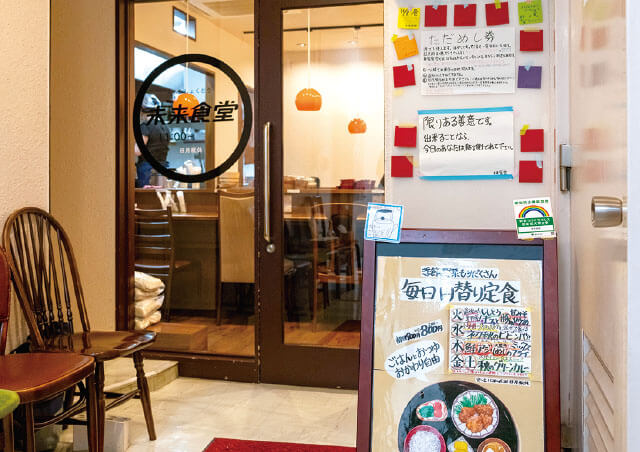
Mirai Shokudo—a small eatery with 12 seats
In addition to makanai and tadameshi, Mirai Shokudo attracts enormous attention for its other unique systems. One example is atsurae, which allows customers to customize their set meal by selecting their favorite small dishes. At the base of these unique systems, is Kobayashi's desire to create an eatery where anyone can enjoy a meal, even while Kobayashi manages the eatery by herself.
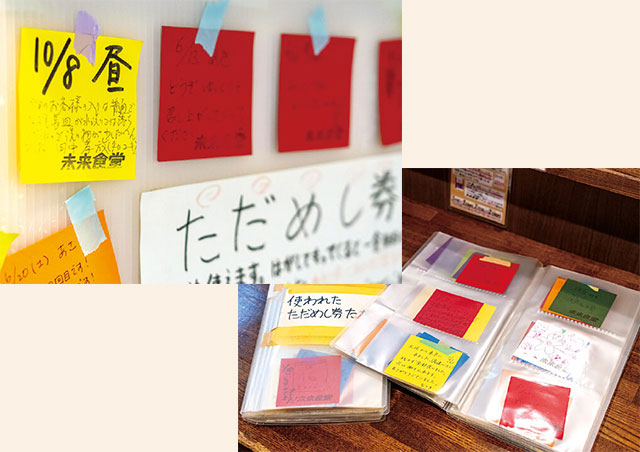
A tadameshi ticket is left by a person who did makanai, which is 50 minutes of help for a free meal. The tadameshi tickets are affixed to the wall at the entrance of the eatery. Any single customer can use a tadameshi ticket for one free meal. There are few opportunities for an actual meeting between the person posting the tadameshi ticket and the person using it. This asynchronicity is the unique style of Mirai Shokudo. Used tadameshi tickets can be viewed in a file kept at the eatery.
How information spreads through the media
MurataWhen drawing a diagram, a normal model would position Mirai Shokudo at the center. We would then consider what kinds of groups exist around the eatery. When considering how the impact will spread, influence may be limited if people with close relationships are gathered.
KobayashiDoes that mean that the identity of people delivering information is important?
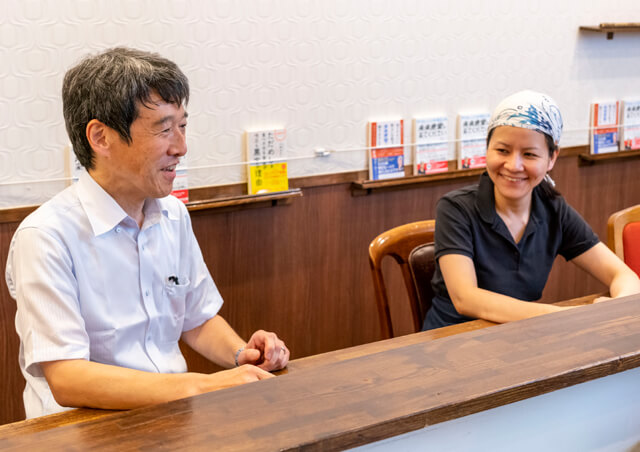
MurataThat's right. Influence may spread on a wider scale when disseminated from different positions by people with varying attributes. When you want to spread information to the greatest possible extent, the influence maximization problem is difficult to solve. Furthermore, as the scale grows larger, this problem becomes exponentially more unmanageable. In a book that you wrote, you mentioned the differences in your influence after Mirai Shokudo was featured by various media outlets.
KobayashiWhen Mirai Shokudo was featured for its business model, that was on television. Afterwards, I received more and more requests for interviews from people who had seen that TV program. In other words, the TV program was the epicenter, and then there was a unique ripple effect that resembled subsequent shockwaves. Also, many people came to the eatery after hearing a radio advertisement, but no one remembers the name of the radio program. When considering that people always remember the name of TV programs and newspapers, it's interesting how the human brain works.
MurataI agree. The way in which information is disseminated is interesting. Are there also many people from far away who come here after hearing such information?
KobayashiWell, the eatery was featured in Newsweek, so many foreigners come directly from Narita Airport. Personally, I believe that restaurants and stores want to control the dissemination of such information. What is your opinion of methodologies such as promotional campaigns using SNS, and the spread of such methods?
MurataThere are times when a meticulously calculated plan will succeed, but there are also times when such plans will fail. Human beings are reluctant to participate in artificial movements. Oftentimes, there will be a backlash once consumers learn that they are being manipulated. Moreover, there is no guarantee that a trend can be manufactured simply by involving a large number of people. There are many researchers who specialize in analyzing how a small number of groups are responsible for creating numerous rumors. When Mirai Shokudo is featured in one media outlet, it spreads to other rival media outlets. This is a unique process and I'm amazed that it has not been interrupted.
KobayashiI was also interviewed regarding the COVID-19 pandemic. It was difficult to film the interview while maintaining appropriate social distancing inside the eatery. Research on networks fulfills a big role during an age when infectious diseases are having such a huge impact on society.
MurataFor example, one of the most studied research themes currently is an infection model that shows how many people are infected by COVID-19, how many people have been cured, the ratio of healthy individuals in each network, and how symptoms change over time through certain connections. There are an increasing number of researchers throughout the world who are studying the spread of COVID-19. For example, a certain academic journal posted a paper which applied data to an infection model in order to explain the terrible spread of infections during the initial period in Italy. Efforts are being made to develop drugs by using computer simulations to examine the structure of compounds that are effective against COVID-19 and to analyze the repurposing of existing drugs. Both in models that depict the transmission of the infection itself and when considering drug development, networks are increasingly important.
Networks for maintaining social distancing
KobayashiHow do you think that SNS and other forms of connecting over the internet will change? Will it be an era where face-to-face meetings are restricted?
MurataFirst, we must consider how to collect the data. For example, at the current point in time, there are possibilities for using apps that detect contact with an infected person. Nevertheless, it is difficult to make predictions based on data because of privacy issues and differences depending on the country.
KobayashiThat's true. Mirai Shokudo functions as a place where people can actually meet. This is an issue which I have to consider; specifically, what changes will occur among future connections. In addition to the tadameshi ticket connection I mentioned earlier, various people help operate the eatery through a system called makanai. Currently, there is a network of about twelve to thirteen restaurants which have been opened by people who want to run a restaurant similar to Mirai Shokudo. They have online meetings to decide the weekly menu, and they send each other information on seasonal ingredients. In this way, they have established flexible connections.
MurataThis shows how open-minded you truly are. It's interesting how you cultivate future rivals by allowing them to train in your own kitchen, and how you have built a network including people from various fields.
KobayashiInstead of creating the same type of restaurant in the form of a chain store, I find it interesting when people use what they learned at Mirai Shokudo to freely change and grow. There are certain generations of people who use the makanai system. Classmates get along well and they often come together to help out via the makanai system. This enables them to gain various types of experience. We have a network that offers this high degree of freedom.
MurataWhen you first developed the idea of the makanai system, did you foresee the development of a network?
KobayashiI had already decided to operate the eatery via the makanai system at the time of opening. I believed that people seeking to hone their skills would come to the eatery. After all, this is how I thought during my own culinary training. However, I didn't consider a future in which circles would become complicated and networks would be formed once restaurants had been opened by people who had used the makanai system. Those people absorbed various concepts while participating in the makanai system and are now applying those concepts to their own restaurants. I have had the unique experience of cultivating skills and knowledge in relationships and environments with open-minded people. Based on this experience, I believe that this expansive network is a very good thing.
MurataWhen someone helps in the kitchen of the Mirai Shokudo, you assign suitable tasks to the makanai helper so that they can effectively improve their skills in a comfortable working environment. As a faculty member, I often teach students that they need English in order to study and write academic papers; however, they should first study Japanese for using language to properly convey ideas. I tell my students to become able to explain the details of their research to anyone in an easy-to-understand manner.
KobayashiI agree with you. The ability to explain is important for communicating with another person. At Mirai Shokudo, I allow people who help via the makanai system to advertise their own restaurants. There are many people with excellent culinary skills. However, even if they make leaflets that introduce their cooking, they tend to write specialized comments that are difficult for the general public to comprehend, and they fail to gain understanding. That's when they realize that there is a gap between what they want to convey and the level desired by their audience.
MurataThe importance of communication skills is often overstated these days. Still, such skills are indispensable for making connections with people.
A place for connecting asynchronously
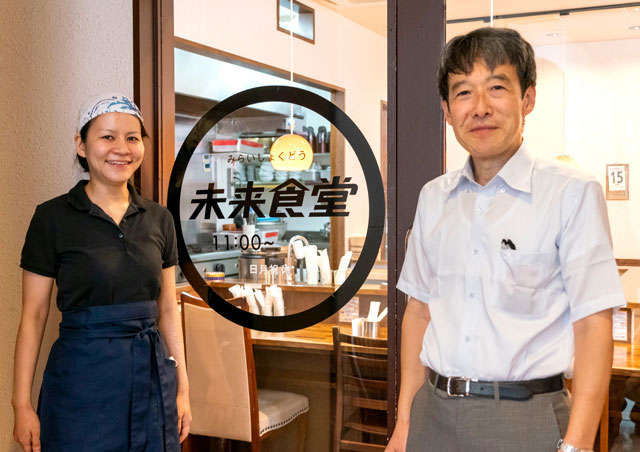
MurataI saw that you published a business plan online. Making it open-source is quite novel. From where did your idea originate?
KobayashiMy goal is to develop a business plan based on science and engineering logic. For restaurants, the unit price and other figures are within a realistic range. From that point, I arrived at the current system as an extension of what I learned from the Department of Mathematics, with the goal of persuading customers to spend an additional 300 yen.
MurataI believe that it is difficult to think systematically in the food-service industry. However, in this way, people with mathematical backgrounds are building their own unique community at each restaurant. Until now, the idea of separating matters into the humanities and sciences has been rooted strongly in Japan. However, moving forward, I believe that networks which blend the humanities and sciences in various fields will become commonplace. Furthermore, in the post COVID-19 era, the flow of people is restricted by physical distance, and the opportunity to meet face-to-face becomes valuable. It is becoming more expensive for people to meet. Therefore, as we discussed earlier, I believe that there will be an increase in asynchronous connections with a slight time difference, rather than connecting in real-time.
KobayashiTrue. On the contrary, the number of SNS followers and page views will be visualized and expanded on the instantaneous internet. In that respect, isn't there an increase in opportunities for pursuing knowledge exactly in your field of research?
MurataAs I mentioned earlier, people cannot be drawn in when they feel something artificial, and that makes the phenomenon difficult to study as a mathematical model. That being said, it is an interesting problem to pursue as an academic discipline.
KobayashiIt's typical of professors at Tokyo Tech to pursue their interests as research rather than an interest in worldly issues. (laughs)
MurataIs that so? (laughs) Information networks have diverse structures. For example, it is important to analyze what hashtags are used and how they transition. This is related to a type of research called "link prediction," which is research on the transition of human relationships.
KobayashiOn SNS, there is a function that displays "People You May Know."
MurataThat's right. The function predicts that A and B will someday be connected. The reason why candidates for connection can be recommended is that they have many friends in common, are in close physical proximity, and have similar attributes. Each one of these definitions is a research theme. It is also a field where sociology and informatics intersect. We also analyzed the trends on Twitter after the Great East Japan Earthquake. By doing so, we obtained data showing that when a celebrity with a large number of followers highlights certain information, that celebrity would function as a broadcasting station that spreads the information. Moving forward, we will research whether or not this was effective in saving lives. Even so, Mirai Shokudo is widely recognized even though you don't actively promote it on SNS.
KobayashiActually, it's my policy not to disseminate information on the eatery via SNS. Small shops and young entrepreneurs tend to create personal SNS accounts. However, if you sell your own personality, you will eventually run out of material. I believe that businesses should sell products. Therefore, I basically only promote my books. Besides, my stance is promoting my books as Mirai Shokudo, not myself. One feature of Mirai Shokudo is that I do not stand out; rather, the eatery is operated through connections with surrounding individuals. I believe that this will be one form of networks in the future. I think that these vague but comfortable connections are the most attractive point of this eatery.
MurataJust as these kinds of flexible relationships spread via Mirai Shokudo and attract the attention of many people, there will be a need for connecting people through physical venues in the future. At that time, in addition to whom you met, where you met that person will also become a valuable element of networks.
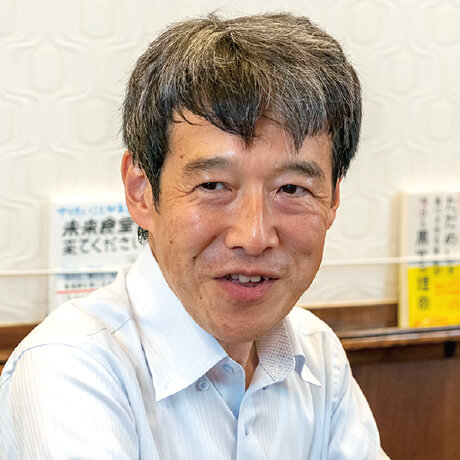
Tsuyoshi Murata
Professor, School of Computing, Tokyo Institute of Technology
In 1992, received a master's degree from the Division of Science Department of Information Science, the University of Tokyo. Appointed as a Research Associate in the Department of Computer Science at the School of Engineering, Tokyo Institute of Technology. In 1998, appointed as a Research Assistant in the Department of Computer Science at the Faculty of Engineering, Gunma University. Appointed as a Lecturer at the same department in 2000. In 2001, became an Assistant Professor of Foundations of Informatics Research Division at the National Institute of Informatics. In 2005, appointed as an Assistant Professor at the Department of Computer Science, the Graduate School of Information Science and Engineering, Tokyo Institute of Technology. Appointed as an Associate Professor at the same graduate school in 2007, and then assumed his current position from 2020. His main research themes are artificial intelligence, machine learning, and social network analysis. He supervises for the Department of Computer Science, graduate major in Artificial Intelligence.
Murata Laboratory
The Murata Laboratory is conducting research on artificial intelligence, especially network science, machine learning, and Web mining. The lab's diverse research themes include deep learning for structured data, classification and relation prediction in networks, and influence maximization in networks. Murata Laboratory is working on extracting knowledge of networks, including prediction of human relationships by accelerating and visualizing community detection.
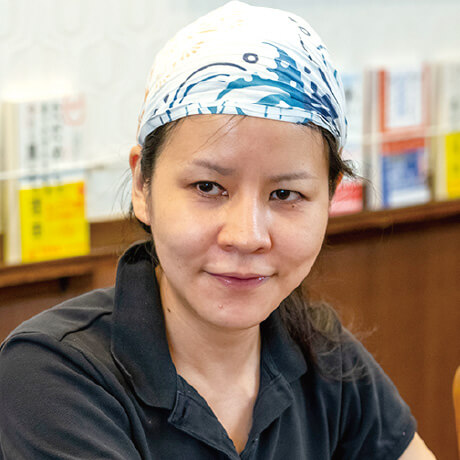
Sekai Kobayashi
Owner, Mirai Shokudo
Born in Osaka Prefecture in 1984. Graduated from the Department of Mathematics at the School of Science, Tokyo Institute of Technology. After having worked as an engineer at IBM Japan and Cookpad for six and a half years, she trained at various restaurants and opened Mirai Shokudo in 2015. At Mirai Shokudo, she has introduced distinctive systems including makanai, tadameshi, and atsurae, as well as unique management measure such as disclosing monthly business results. Her written works include Mirai Shokudo ga Dekiru Made (Opening the Mirai Shokudo) (Shogakukan) and Tadameshi wo Tabesaseru Shokudo ga Kyou mo Kuroji no Riyu (The Reason Why an Eatery Serving Free Meals is Continually Profitable) (Ohta Publishing Company).
The Special Topics component of the Tokyo Tech Website shines a spotlight on recent developments in research and education, achievements of its community members, and special events and news from the Institute.
Past features can be viewed in the Special Topics Gallery.
. Any information published on this site will be valid in relation to Science Tokyo.






